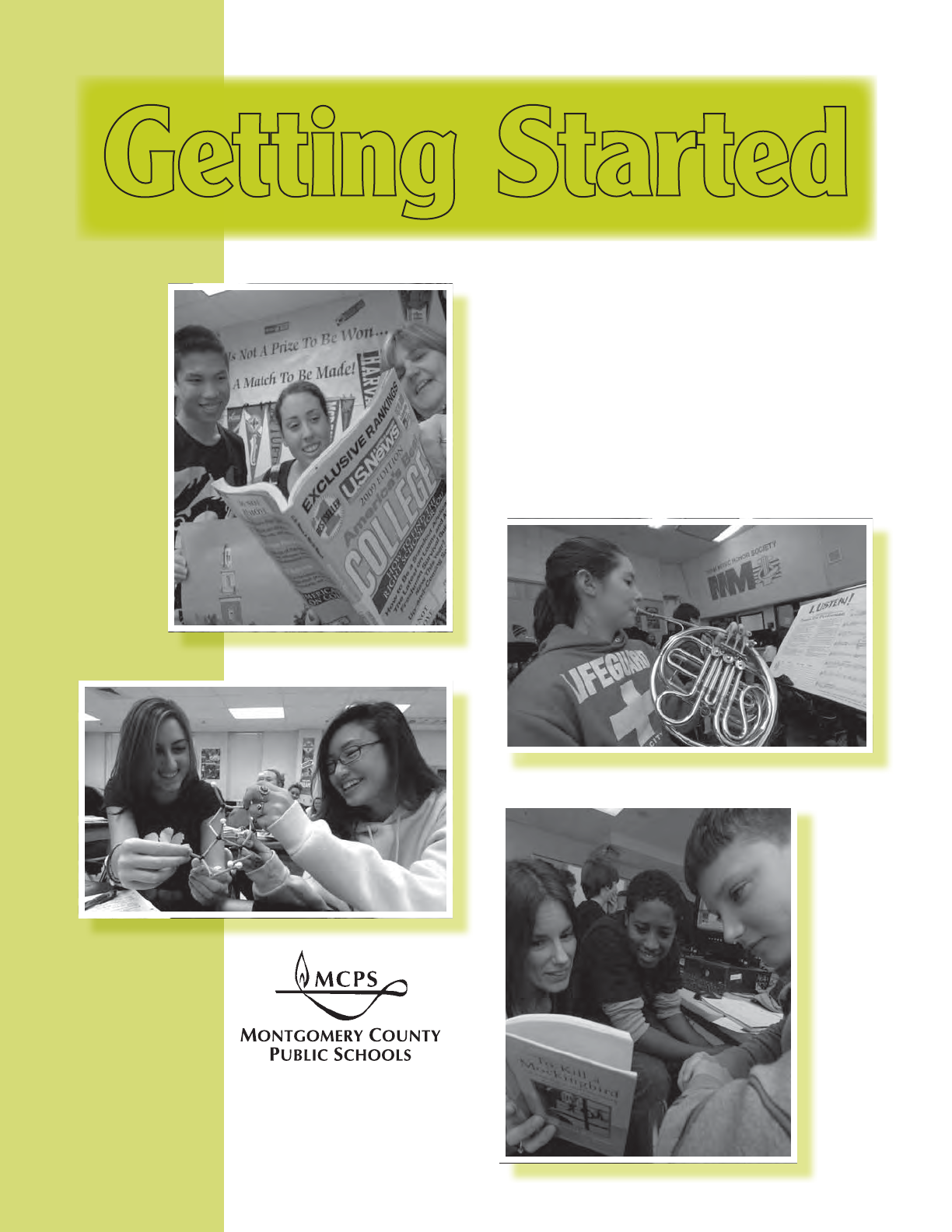
Career/College
Planning
Guide
for Ninth Grade Students
Getting Started
Rockville, Maryland

VISION
A high-quality education is
the fundamental right of every
child. All children will receive
the respect, encouragement,
and opportunities they need
to build the knowledge, skills,
and attitudes to be successful,
contributing members of a
global society.
Board of Education
Ms. Shirley Brandman
President
Mrs. Patricia B. O’Neill
Vice President
Mr. Christopher S. Barclay
Ms. Laura Berthiaume
Dr. Judith R. Docca
Mr. Michael A. Durso
Mr. Philip Kauffman
Mr. Timothy T. Hwang
Student Member
School Administration
Dr. Jerry D. Weast
Superintendent of Schools
Mr. Larry A. Bowers
Chief Operating Officer
Dr. Frieda K. Lacey
Deputy Superintendent of Schools
850 Hungerford Drive
Rockville, Maryland 20850
www.montgomeryschoolsmd.org

Getting Started
Career/College Planning Guide
for Ninth Grade Students
In high school, you will be involved in various academic, community, and social activities.
Each of these activities will provide a wealth of experiences and help clarify your interests,
goals, and plans for the future. Active involvement in high school is one key to a success-
ful and rewarding high school experience. Get involved, take charge, and become the best
student you can be. As you and your parents plan your program, your school counselor is
available to help you every step of the way.
This handbook is designed to provide you with information about time management and
study skills improvement, decision making, career information, college planning and college
admission tests. Getting started with assignments or work can sometimes be a problem.
However, if you put into practice ideas from this booklet, you may find that your high school
years will be more rewarding. Please ask your school counselor for additional materials or
clarification about information in this handbook.
Montgomery County Public Schools
Office of Special Education and Student Services
Department of Student Services
School Counseling Services Unit
Rockville, Maryland 20850
301-279-3584
This booklet belongs to


Contents
Time Management ....................................... 1
Plan your time .........................................................1
Steps for planning your time
....................................1
Time-planning chart
.................................................1
Weekly list of priorities
............................................2
Decision Making .......................................... 3
Steps in decision making ..........................................3
Personal Mission Statement ......................... 4
Writing a personal mission statement .......................4
My personal mission statement
................................ 5
Countdown to Graduation ............................8
Ninth grade .............................................................. 8
Tenth grade
.............................................................. 8
Eleventh grade
.........................................................8
Twelfth Grade
.......................................................... 9
Definitions ................................................ 10
Career Planning
........................................ 11
What is career planning? ........................................ 11
What career assessments are available?
................... 11
Choices Explorer
....................................................... 11
WorkSpaceK12/Career Interest Profiler
................... 11
Career interest and aptitude tests
............................. 11
MCPS Career Clusters
............................................ 12
Other Sources of
Career Planning Information .................. 13
What To Do After High School
.................... 14
Apprenticeship programs ........................................14
College/University
..................................................14
Military training
.....................................................14
Trade and technical training
...................................14
Work/Postsecondary education
...............................14
College Planning ....................................... 15
College admission requirements .............................15
College admission and placement tests
................... 15
Early College-planning tips
.....................................16
Grade 9
......................................................................16
Grade 10
....................................................................16
Articulation Program at Montgomery College
.........16
A Quick College-Planning Guide for
Students with Special Needs .................. 17
Develop self-awareness ...........................................17
Practice self-advocacy
.............................................17
Prepare yourself well
.............................................. 17
Explore options
......................................................17
Complete the application process
............................ 17
Student Educational and
Planning Worksheet ............................... 19
Contents • i
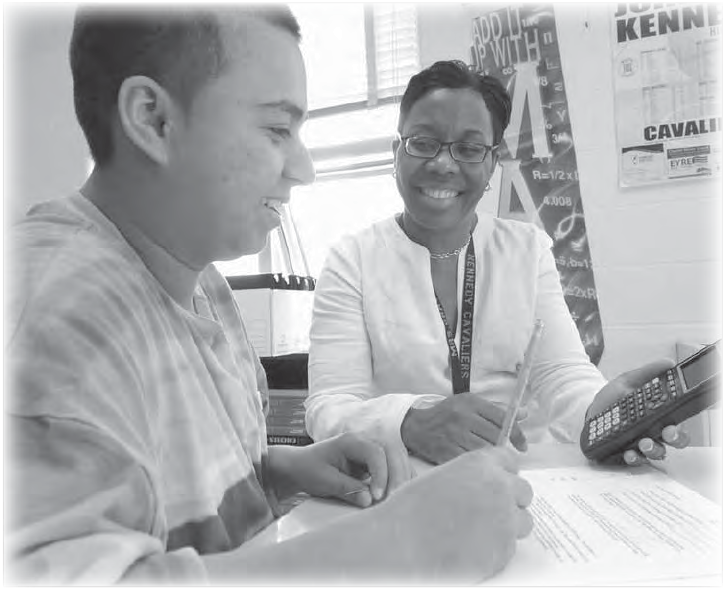

Time Management
Plan your time
Success in school depends on how well you plan your
time. Your time should be planned so that you can get
your work done and still have time for yourself. Your
schedule should be comfortable. Planning your time to
fit your needs will help you to be successful.
How do you spend your time? Do you have time to do
all the things you really want to do? Make photocop-
ies of the time-planning chart below. Use it to keep a
record of how you spend your time for one week. At
the end of the week, look at the chart and ask yourself
these questions:
■ What are three main ways I spend my time?
■ Do I like the way I am spending my time?
■ What would I like to change?
Now use the weekly list of priorities chart to plan next
week. Using the time-planning chart you copied, plan a
schedule for all the things you must do and the things
you would like to do. Use the five steps in this booklet
for planning your time and completing your schedule.
Some weeks are busier than others, with just too many
tasks to do. Sometimes it is hard to decide which im-
portant activity to do first. Following a time-manage-
ment plan should help you complete your major tasks.
Steps for planning your time
Step 1. List everything that you have to do for a whole
week.
Step 2.
Give every job or activity a time and place.
Write this on a time chart.
Step 3.
Make changes in your schedule (revise your
schedule) as the week passes.
Step 4
. Check off each item on the schedule after you
have done it.
Step 5.
Reward yourself when you finish a very hard
task.
Time-planning chart
Monday Tuesday Wednesday Thursday Friday Saturday Sunday
6 a.m.
7 a.m.
8 a.m.
9 a.m.
10 a.m.
11 a.m.
12 noon
1 p.m.
2 p.m.
3 p.m.
4 p.m.
5 p.m.
6 p.m.
7 p.m.
8 p.m.
9 p.m.
Time Management • 1

Weekly list of priorities
Use this sheet to plan.
1. Make a list of things you always do each week.
2. Make a list of other things you must do this week.
3. Make a list of things you would like to do this week, if you have time.
Things I always do each week
1.
2.
3.
4.
5.
Other things I must do this week
For school:
1.
2.
3.
4.
5.
For home:
1.
2.
3.
4.
5.
Things I would like to do if I have time this week
1.
2.
3.
4.
5.
Now, review your lists. Use the weekly chart to plan another week. Do you see improvements? Sometimes everything
won’t fit into your schedule and some plans must be postponed. Choose the things that are most important to do
first. This is called “setting priorities.”
Review your choices and ask yourself if they are wise ones. You may wish to review your list and plans with your
parents and teachers. With good planning, you will be ready when a big project must be done.
2 • Time Management
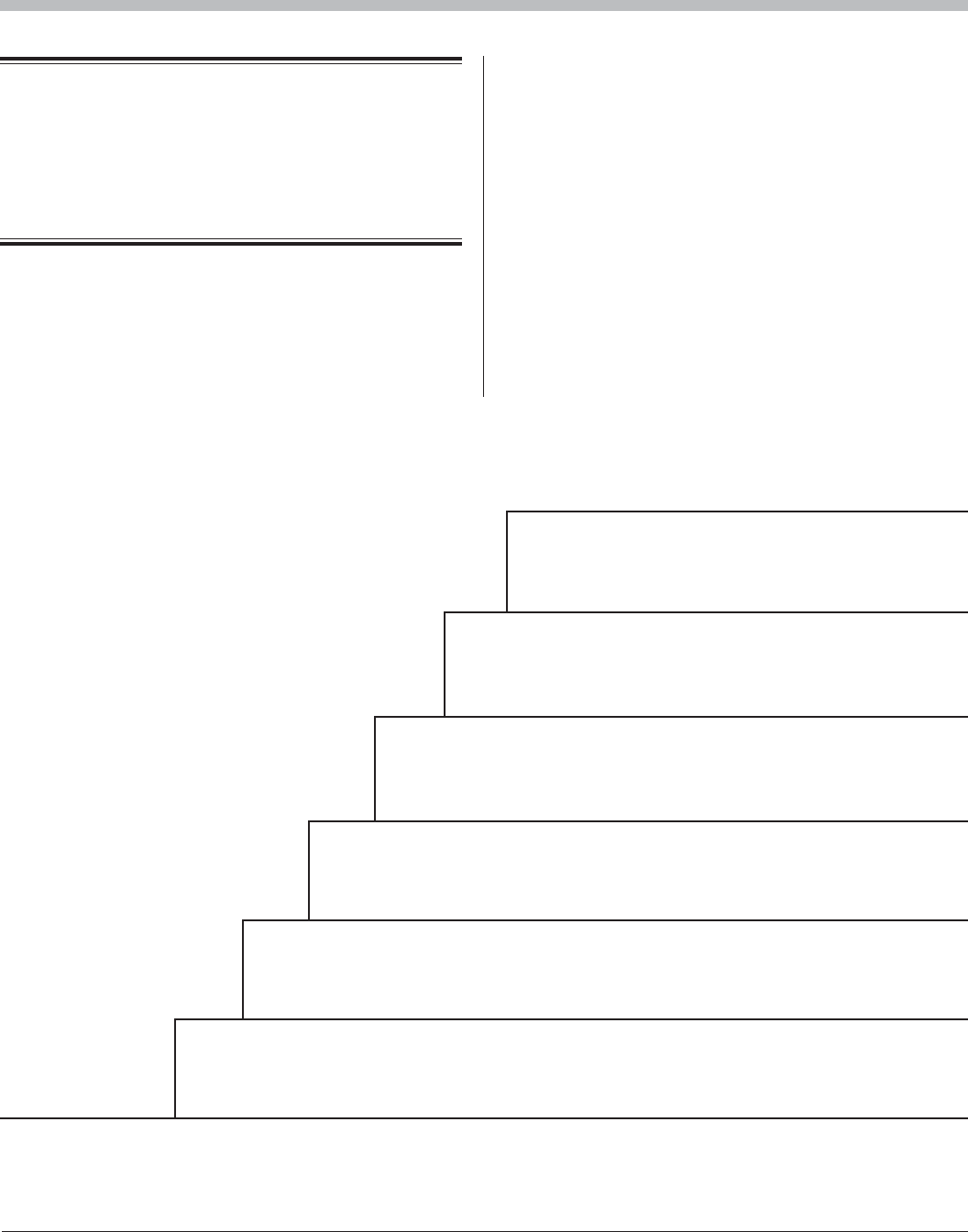
Decision Making
“The quality of the rest of your life
can be enhanced or diminished by the
seemingly unimportant decisions you
make day by day.”
—Margaret C. Morrison
Each of us makes decisions every day. Often, we are
not consciously aware that we have mentally thought
through a situation, discarded ideas, and made note
of advantages. In high school you will be expected to
make many decisions, some of which will affect the rest
of your high school years and beyond. Now is a good
time to give thought to the many important decisions
you will have to make in high school.
What decisions will you make about the following:
■ Should I go to college? Get a full-time job? Join the
military? Attend a technical school?
■ Should I take a college preparation curriculum?
■ Should I take Honors and advanced courses?
Good decisions require careful thought. Use the chart
below to help organize your decision-making pro-
cedures. This process can help you to make decisions
about careers, course selection, college choices, and
postsecondary plans.
Steps in decision making
Decision Making • 3
Check out how it
worked
Make plans and
act on decision
Decide on best
alternative
Evaluate
alternatives
Generate
alternatives
Identify
problem
Review the outcome of your
decision. Go through the steps
again if you are dissatisfied.
Plan specific ways to act on
your decisioin and then begin.
Select the alternative that is
best for you. It may be a
combination of alternatives.
Determine the consequences of each
decision or solution. List the advantages
and disadvantages for each.
List several possible solutions.
Identify the problem or decision.
6
5
4
3
2
1
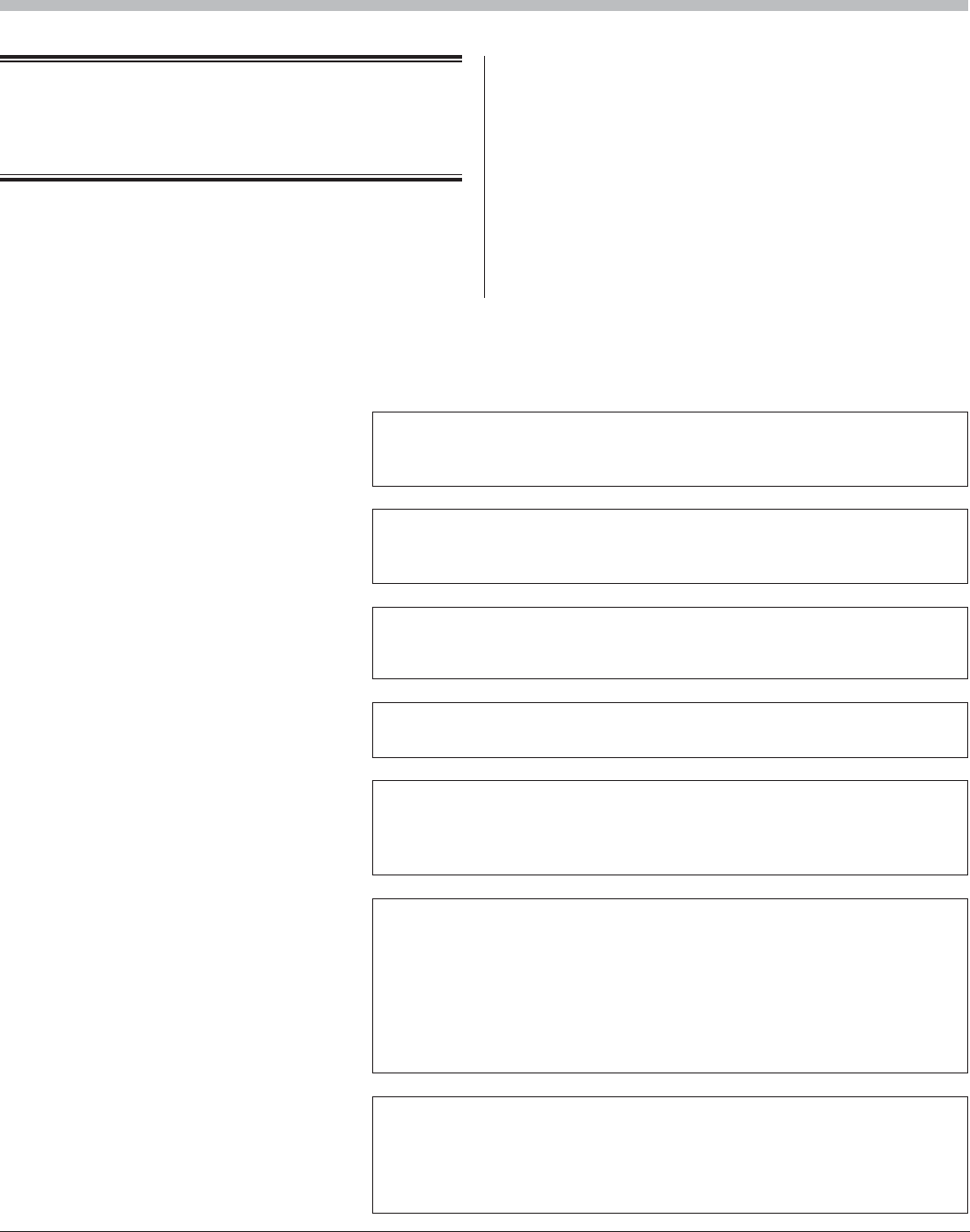
Personal Mission Statement
“It takes courage to grow up and turn
out to be who you really are.”
—e.e. cummings
You can use your knowledge about yourself to help
define your personal and career goals. The more you
know about yourself, the more successful you will be in
defining goals within the framework of your own values.
Take the time to complete the personal mission state-
ment. Use the first worksheet as a prewriting tool to
help you brainstorm your various ideas. Next, write
your statements, expressing your ideas in sentence/
paragraph form on the “My Personal Mission State-
ment Worksheet.”
You may not know “what you want to be,” but you
should begin thinking about “the kind of person you
want to be.” Revisit your personal mission comments
from time to time, and update information as necessary.
Writing a personal mission statement
Prewriting, brainstorming: Asking yourself about you
Who I am
(Roles like student, daughter, brother; your
personality—serious, social, giving, quiet,
fair, helpful, open-minded, etc.)
My strengths and talents
(A leader, creative, intelligent, hard-work-
ing, artistic, athletic, peacemaker, good com-
municator, team player, enthusiastic, etc.)
My weaknesses
(Fearful/timid, a procrastinator, insecure,
narrow-minded, disorganized, constantly late,
lose temper easily, etc.)
My values
(Excellence, justice, service, ethical, reli-
gious, honesty, personal growth, etc.)
What I hope to become in life
(Career path, dependable, forgiving, loyal,
dedicated to…, courageous, principle-cen-
tered, balanced, happy, monetarily
successful, secure, healthy, etc.)
Specific goals
(Short term: academic commitment, ac-
cept responsibilities, read more, take an “out-
side school” class or instruction in your area
of interest, community service, better diet,
more sleep, more exercise, spend more time
with family, etc. Long term: go to college or
vocational school, pursue a specific career,
improve “weaknesses,” develop talents, etc.)
Steps necessary to reach my goals
(Seek help in a specific subject; go to
library once a week to check out a book of
interest; study at least “x” number of hours a
night regardless of homework; take an outside
class on arts, sports, or computers, etc.)
4 • Personal Mission Statement

My personal mission statement
Name I, ,
Who I am
recognize my strengths and develop my talents as a person who is
My strengths and talents
and acknowledge my weaknesses
My weaknesses
I hope to lead a life centered on the following beliefs (values):
My values
and envision myself becoming a person who is
The kind of person
I hope to
become in life
I have set these goals in order to fulfill my hopes:
Specific goals
I will start on this journey by taking one or more steps this year. I plan to
Steps necessary to
reach my goals
Personal Mission Statement • 5

Important Graduation Considerations
Which mathematics courses should I take?
Have I developed my skills to the point where I
can take higher-level mathematics courses?
Which mathematic courses will provide the best
preparation for careers that interest me?
The Pathways to Success in Mathematics chart, pres-
ents the Montgomery County Public Schools (MCPS)
mathematics sequence. The more advanced the math
courses you take, the more college and career options
are available to you.
One of the most important things that you will do in
high school is to carefully select the courses that you
will take each year. Every choice you make will open
up new opportunities and possibly close down others.
While all of your course selections are important, the
choices that you make in mathematics courses can
have a profound impact upon your options in other
subjects and upon your college and career plans.
6 • Personal Mission Statement
Student Service Learning (SSL)
Another important graduation requirement is Student
Service Learning (SSL). Students graduating in 2011
or later will need to earn 75 SSL hours. Earning these
hours not only enables you to meet a graduation re-
quirement but also provides you with an opportunity to
experience areas that you might want to consider when
exploring possible careers. For further information on
SSL go to www.montgomeryschoolsmd.org/
department/ssl/.
Promotion Requirements
For students in grades nine through twelve, the follow-
ing should apply:
■ To be promoted to the tenth grade, a student should
have a minimum of five units of credit
■ To be promoted to the eleventh grade, a student
should have a minimum of ten units of credit
■ To be promoted to the twelfth grade, a student
should have a minimum of fifteen units of credit
Graduating Classes of 2009 and Later
Subject Area Specific Credit Requirements
English
4 credits
Fine Arts
1 credit (Selected courses in art, dance, drama/theater, and music that satisfy the fine arts
requirement are marked FA)
Health Education
0.5 credit
Mathematics
4 credits** (1 credit algebra, 1 credit geometry.) Students who successfully complete a
calculus course may be exempted from this 4 credit requirements.
Physical Education
1 credit
Science
3 credits (1 biology credit and 1 physical science credit must be included)
Social Studies
3 credits (1 U.S. History credit; 1 World History credit; and 1 National, State, and Local
Government credit)
Technology Education
1 credit (Courses in career and technology education that satisfy the technology education
requirement are marked in the High School Course Bulletin.)
Other Courses
2 credits in a foreign language, or 2 credits in advanced technology education and 2.5 credits
in electives OR 4 credits in a state-approved career and technology program and 0.5 credit in
general electives
Assessments
High School Assessments
Students must meet the Maryland High School Assessment (HSA) graduation requirement for
English, algebra/data analysis, biology, and government by achieving one of the following:
1. Pass all four HSA tests.
2. Earn a combined score of 1602 or higher.
3. Complete required Bridge Plan project(s). The number of projects a student must
complete is based on his or her highest HSA test score.
www.montgomeryschoolsmd.org/curriculum/coursebulletin/diplomaRequirements.cfm
Maryland Diploma Requirements

Personal Mission Statement • 7
Pathways to Success in Mathematics
Pathways to Success in Mathematics
Grade K Grade 1 Grade 2 Grade 3 Grade 4 Grade 5 Grade 6 Grade 7 Grade 8 Grade 9 Grade 10 Grade 11 Grade 12
Grade K Grade 1 Grade 2 Grade 3 Grade 4 Grade 5 Grade 6 Grade 7 Grade 8 Grade 9 Grade 10 Grade 11 Grade 12
This chart shows some of the many options that students have in the progression of mathematics courses from Kindergarten through Grade 12.
Courses are presented in columns by grade level, starting with Kindergarten on the far left side of the chart and moving to Grade 12 on the far right.
Acceleration occurs in Kindergarten through Grade 8. Acceleration does not mean that the student “skips” a course. For example, when the broken
red arrow shows a path that takes a student from Math 2 in Grade 2 to Math 4 in Grade 3, this means that the student has mastered the content of both
Math 2 and Math 3 in Grade 2 before moving into Math 4 in the next grade. It is important for a student to demonstrate proficiency in the content of a
course before he/she is moved to the next level. Students have the option to move from an on-level course to Honors or Advanced Placement courses
at any time throughout high school.
Math 4
Math 3 Math 1 Math K Math 2
Math 4
Math 5
Math 5
Math 2 Math K
Math 6
Math 3
Math 6 Math 5
Math 7
Math 7
Double
Period
Math 7
Algebra 1
Honors
Geometry
Algebra 1
Investigations
into
Mathematics (IM)
Math 6
Math 7
Honors
Precalculus
Honors
Geometry
Algebra 1
Honors
Algebra 2
Advanced
Placement (AP)
Statistics
Geometry Algebra 2
Algebra Prep
Honors
Algebra 2
Honors
Geometry
Honors
Precalculus
Honors
Algebra 2
Advanced
Placement (AP)
Calculus
Investigations
into
Mathematics (IM)
Advanced
Placement (AP)
Calculus
College-Level
Math
Advanced
Placement (AP)
Calculus
Calculus with
Applications
Advanced
Placement (AP)
Statistics
Precalculus
College-Level
Math
Advanced
Placement (AP)
Statistics
Honors
Precalculus
Bridge to
Algebra 2
Algebra 2
Geometry
Algebra 1
Algebra 1 &
Related Math
Quantitative
Literacy
Algebra 2
Precalculus
Honors
Algebra 2
Honors
Geometry
Honors
Precalculus
Pathways are indicated by the arrows.
Dark blue arrows represent standard
or non-accelerated progression
between courses.
Broken red arrows represent the
accelerated pathways based on
proficiency.

8 • Countdown to Graduation
Good decisions follow a timetable. When you complete each task, record the date.
Ninth grade
Fall
Make an appointment to meet with your counselor.
Discuss your academic/career plans and per-
sonal and academic strengths.
Visit your college/career center. Become famil-
iar with the resources available there.
Participate in school extracurricular activities.
Take the Preliminary Scholastic Assessment
Test (PSAT)
Spring
Begin working with Choices Explorer.
Make an appointment with your counselor to
review your academic progress and plan your
program for next year. Talk about your grades.
Remember the grades earned in the ninth grade
are part of your official high school transcript.
Attend career information programs.
Work on earning your student service learning
hours.
Tenth grade
Fall
Continue your participation in extracurricular
activities.
Take the PSAT. Check with your counselor for
more information.
Visit your college/career center.
Continue working with Choices Explorer.
Winter
Talk with your counselor about your grades.
Meet with your counselor to discuss results of
the PSAT.
Find out what kinds of postsecondary schools
offer the education you need to meet your
career plans.
Spring
Plan next year’s program to reflect your inter-
ests, school progress, and emerging career plans.
Continue working with Choices Explorer.
Consider career and technology course offer-
ings at the Thomas Edison High School of
Technology.
Summer
Continue earning student service learning
hours, particularly through activities related to
potential career plans.
Eleventh grade
Fall
Take the PSAT and the National Merit Scholar-
ship Qualifying Test (NMSQT).
Attend college programs sponsored by your
counseling department.
Attend career presentations sponsored by your
school, MCPS, and the business community.
Acquire volunteer or job experiences related to
career plans.
Monitor your student service learning hours.
Fall/Winter
Meet with your counselor about your progress.
Meet with college admissions representatives
who visit your school.
Get information on apprenticeship programs.
Get information on trade and technical schools.
Take career interest inventories.
Continue working with Choices Explorer or
Choices Planner.
Begin working with WorkSpaceK12 to identify
colleges and universities to which you might
apply.
Early Spring
Consider career goals as you select classes and
revise your high school planning sheet.
Plan next year’s program to enhance prospects
for employment opportunities and college ad-
missions.
Work with your counselor to determine if you
are ready for American College Testing (ACT),
Scholastic Achievement Test (SAT),
ACCUPLACER or SAT Subject Tests.
Use the computer search programs to identify
appropriate colleges and/or trade and technical
schools.
Consider an internship for your senior year.
Countdown to Graduation
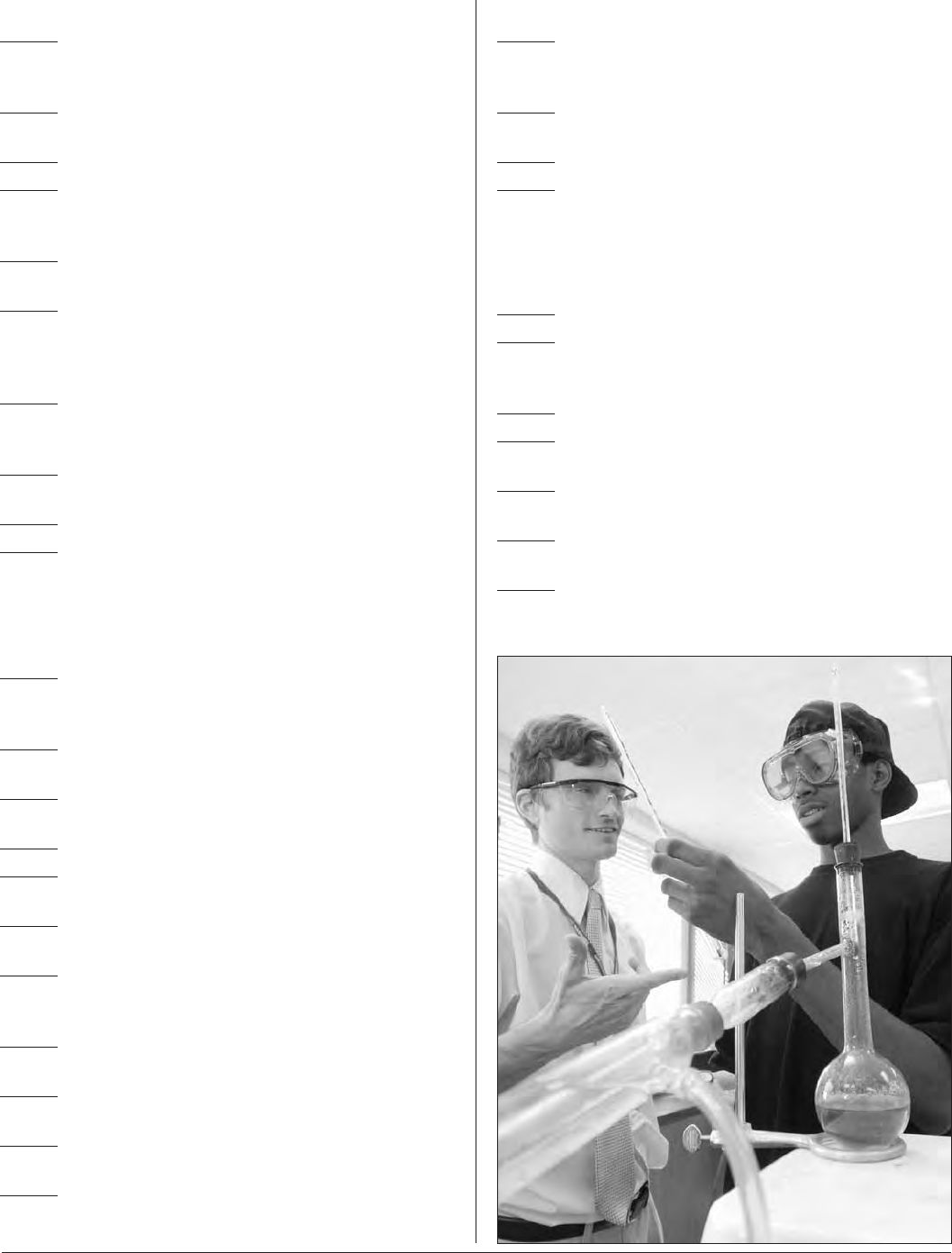
Countdown to Graduation • 9
Spring
Attend college fairs and school-sponsored
programs. Confer with your counselor about
postsecondary plans.
Register for ACT, SAT, ACCUPLACER and/or
SAT Subject Tests as appropriate.
Attend career information programs.
Spend time in the college/career center explor-
ing materials. Find out about summer enrich-
ment programs.
Begin visiting colleges and /or trade and techni-
cal schools.
Assemble a file of materials collected from
colleges and/or trade and technical schools
and those distributed by your counseling
department.
Make interview appointments for the summer
or early fall if appropriate. Practice interviewing
skills.
Become familiar with college and job
applications.
Develop your résumé/personal references.
Continue earning student service learning
hours if needed.
Twelfth Grade
Summer/Fall
Make an appointment with your counselor for
you and your parents to discuss postsecondary
plans.
Request applications from colleges and/or trade
and technical schools. Set up a file system.
Register for ACT, SAT, ACCUPLACER and/or
Subject Tests as appropriate.
Stay abreast of all scholarship opportunities.
Review high school records, including gradua-
tion requirements.
Complete any remaining student service learn-
ing hours.
Visit college and/or trade and technical schools.
Talk to admissions representatives who visit
your school.
Seek out scholarship information and apply as
appropriate.
Attend college and career programs sponsored
by your counseling department.
Familiarize yourself with your school’s tran-
script request procedure and follow it.
Talk with your counselor about your academic
progress.
Fall/Winter
Fill out college admission applications by
December 1 if possible. Abide by both school
and college deadlines.
Seek letters of recommendation if needed. Give
teachers and counselors sufficient notice.
Complete a résumé.
If appropriate, have your parents complete
the Free Application for Federal Student Aid
(FAFSA) and other financial aid forms, if re-
quired by the college, and file after January 1.
Spring
Attend job fairs.
Contact Maryland Department of Econom-
ics and Employment Development for job
openings.
Maintain good grades and good attendance.
Notify your counselor of your application status
as you hear from the colleges.
Request a final transcript to be sent to the
college you will attend in the fall.
Notify the colleges you are not planning to
attend.
Perfect your job-interviewing skills.

Definitions
In high school, certain terms and their meanings might be confusing. The following listing will help you understand
some of the high school jargon.
High school credits—All subjects in high school are
taught by semester. The semester or final grade is a
compilation of the quarterly grades and the final exam.
A passing final grade in a semester course earns a 0.5
credit. A total of 22 credits in required and elective
subjects is needed to earn a high school diploma. Other
graduation requirements also apply.
Transcript—A transcript is a record of all courses
taken in high school, the level of the courses, and the
final grade earned in each course. Usually, colleges and
employers want to review a student transcript before
accepting a student in a college or a job.
Grade point average (GPA)—Each final grade earned
signifies points. An “A” is 4 points, “B” is 3 points, “C”
is 2 points, “D” is 1 point, and an “E” is 0 points. The
sum of the final grade points divided by the number of
courses determines the cumulative grade point average
(GPA).
Weighted grade point average (WGPA)—An “A,” “B,”
or “C” in an Honors or advanced class earns an addi-
tional point. These increased points result in a “weight-
ed” grade. The sum of the final grade points, including
those “weighted” for Honors and advanced classes
divided by the number of courses, is a cumulative,
weighted grade point average (WGPA). MCPS does not
rank students. A profile of grades by class is provided to
colleges.
Academic eligibility—Students must maintain a 2.0
marking period average with not more than one fail-
ing grade in the preceding marking period in order to
participate in extracurricular activities. The marking
period average is not the same as the GPA.
Student service learning (SSL)—SSL is an unpaid
activity within the curriculum, school, or outside com-
munity that provides service to an individual or group
to address a school or community need. Hours accu-
mulated are counted toward the graduation require-
ment for student service.
National Honor Society (NHS)—This society compris-
es 10th, 11th, and 12th grade students who have dem-
onstrated outstanding accomplishments in academics,
character, leadership, and service. Not all schools have
a chapter of NHS, and there are different eligibility
requirements among the schools that do have chapters.
Check with your counselor or NHS sponsor for more
information.
High school diploma—A diploma is a degree issued to
a student who has successfully met the subject, credit,
and other requirements issued by the state and county
boards of education, met the attendance requirements,
and met the required High School Assessment gradua-
tion requirements.
10 • Definitions
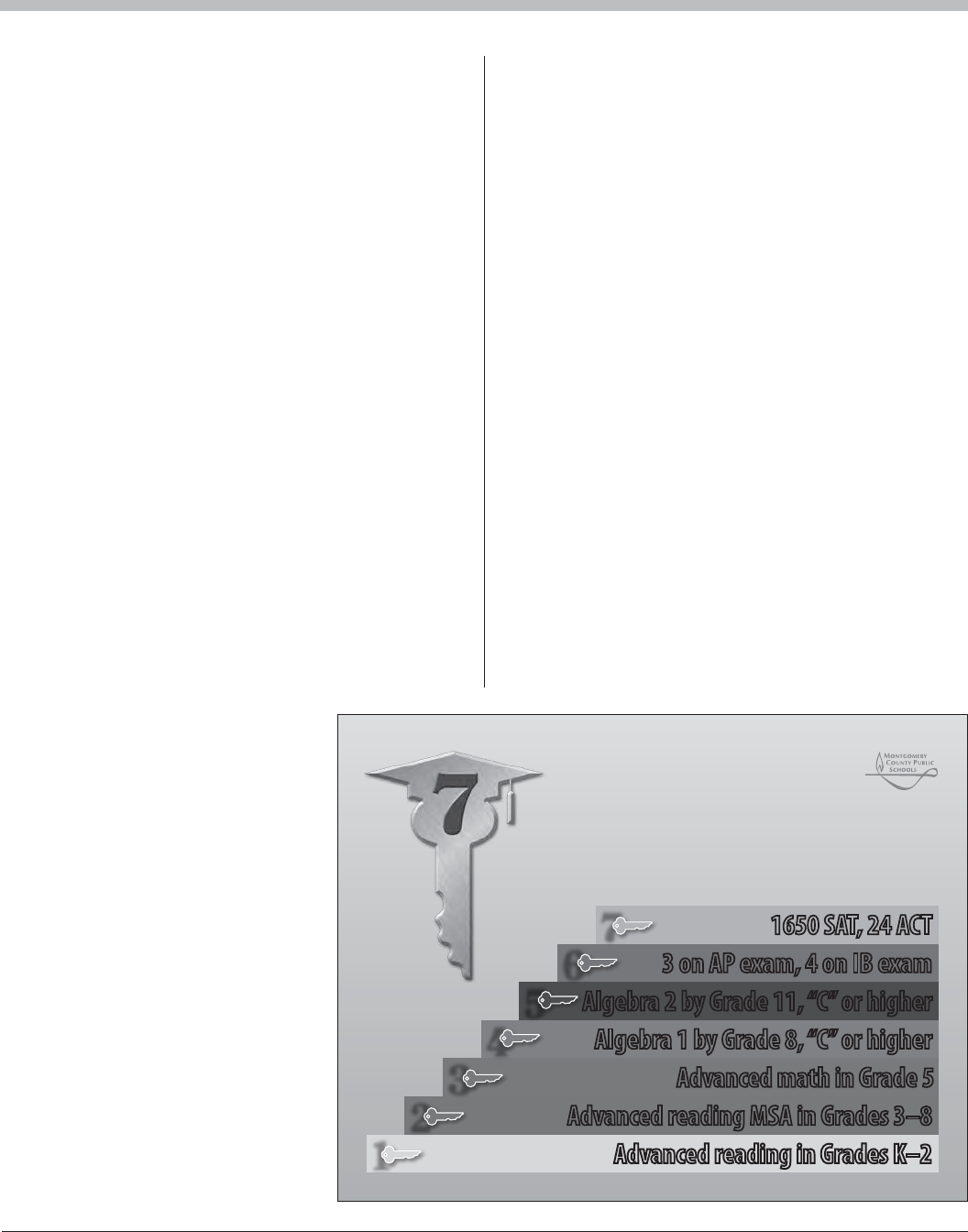
Career Planning
What is career planning?
When you were very young, you were asked, “What
are you going to be when you grow up?” You probably
had several answers. Career planning begins very early
in life and is the accumulation of the experiences (in
school and out) that you have had.
The Seven Keys to College Readiness
The Seven Keys will open the door to college for
students. The Seven Keys are a pathway identified by
Montgomery County Public Schools that will increase
the likelihood of students being ready for college and
earning a degree. These Seven Keys are significantly
more demanding than the state requirements of earn-
ing a high school diploma. This is intentional. Students
who only meet state high school graduation require-
ments may not be prepared to take and do well in
college-level classes. They may be required to take and
pay for remedial courses at their college before starting
college-level work. Students who attain the Seven Keys
are less likely to need remedial classes and are more
likely to be ready for college and the workplace, where
competition for jobs is high.
There will be situations where a student may not attain
one Key or several Keys for any number of reasons.
Some students will attain the Keys with the special
services and accommodations they
receive through their educational
plans. Our children are unique,
and how quickly or how much they
progress will vary. Attaining all Seven
Keys does increase the likelihood
of a student being ready for college,
but missing a Key does not close the
doors to college for any student. It is
important to look at all of a student’s
strengths, as well as the student’s
motivation to succeed.
Your high school has a career center
and a college/career information co-
ordinator (CCIC). The center has ma-
terials to help you learn about your
interests and possible occupations. It
also contains up-to-date information
for career planning. As you review
and revise your high school planning
sheet, speak with your counselor
about your career goals. Your student service learn-
ing activities also will help you find out about different
careers.
Consider enrolling in a Division of Career and Technol-
ogy or Foundation career pathway program while in
high school. These programs give you the opportunity
to earn FREE college tech prep credits at Montgomery
College for courses taken in high school. For more
information about these programs go to www.
montgomeryschoolsmd.org/departments/CTE/toolkit/
index.shtm.
What career assessments
are available?
Students in all MCPS high schools have access to two
powerful career planning Web-based applications:
Choices Explorer and WorkSpaceK12.
Choices Explorer
Students find this site exciting and informative, with
fun articles about careers, recreation, education, and
skills. In Zones, hundreds of occupations are arranged
by career cluster. Career Finder is a quick and easy
self-assessment of interests and skills. Colorful graphics
compare a student’s self-rating of skills and interests
to suggested occupations. Career Research Tool guides
Career Planning • 11
1650 SAT, 24 ACT
3 on AP exam, 4 on IB exam
Algebra 2 by Grade 11, “C” or higher
Algebra 1 by Grade 8, “C” or higher
Advanced math in Grade 5
Advanced reading MSA in Grades 3–8
Advanced reading in Grades K–2
1650 SAT, 24 ACT
3 on AP exam, 4 on IB exam
Algebra 2 by Grade 11, “C” or higher
Algebra 1 by Grade 8, “C” or higher
Advanced math in Grade 5
Advanced reading MSA in Grades 3–8
Advanced reading in Grades K–2
© 200 9 MONTGOMERY COUNT Y PUBLIC SCHOOLS • RO CKVILLE, M ARYLA ND
1
2
3
4
5
6
7
SEVEN KEYS TO
COLLEGE READINESS

MCPS Career Clusters
Existing Career Pathway Programs and Academies
Detailed information, including required courses for program completion, course rigor, graduation requirement, and corresponding articulation
agreements with Montgomery College can be found at www.montgomeryschoolsmd.org/departments/cte.
Arts, HumAnities, mediA,
And CommuniCAtions Cluster
• Broadcast Media
• Printing, Graphics, and Electronic
Media
ConstruCtion And
development Cluster
• Carpentry
• Construction Electricity
• Heating and Air Conditioning
• Masonry
• Plumbing
HumAn And Consumer serviCes,
HospitAlity, And tourism Cluster
• Academy of Hospitality and Tourism,
National
• Cosmetology
• Hospitality Management
• Manicuring/ Nail Technology
• Professional Restaurant Management
engineering, sCientifiC reseArCH, &
mAnufACturing teCHnologies Cluster
• Advanced Engineering
(Project Lead the Way)
• Pre Engineering
BiosCienCes, HeAltH sCienCe,
And mediCine Cluster
• Biotechnology
• Medical Careers
eduCAtion, trAining, And
CHild studies Cluster
• Early Child Development
• Teacher Academy of Maryland
informAtion teCHnologies Cluster
• Academy of Information Technology
National
• Cisco Networking Academy
• Network Operations
• Oracle Academy
trAnsportAtion, distriBution,
And logistiCs Cluster
• Automotive Body Technology/
Dealership Training
• Automotive Technology/ Dealership
Training
• Foundations of Automotive Technology
Business mAnAgement
And finAnCe Cluster
• Academy of Finance, National
• Accounting
• Business Management
• Marketing
environmentAl, AgriCulturAl,
And nAturAl resourCes Cluster
• Environmental Horticulture
• Green Industry Management
• Landscape Design
lAw, government, puBliC sAfety,
And AdministrAtion Cluster
• Fire and Rescue Services/ Emergency
Medical Technician
• Justice, Law, and Society
12 • MCPS Career Clusters
students through Skills, Values, Interests, and Per-
sonality inventories to generate career research leads.
The site license for Choices Explorer allows for career
exploration to be accessed on the Internet—both at
school and at home. Each suggested career can be ex-
plored in detail, and there are Web links to professional
associations, colleges that offer the required courses,
and additional related articles.
WorkSpaceK12
/Career Interest Profiler
While the WorkSpaceK12 is primarily focused on
college admissions and financial aid, it does contain a
powerful Career Interest Profiler. This career interest
inventory enables students to link career interests back
to their college search.
Career interest and aptitude tests
In addition to the Choices Explorer and WorkSpaceK12
online assessment/interest inventory, most career cen-
ter self-administered instruments or other computer
inventories may be done individually or may be used as
part of class assignments. Also available is the Armed
Services Vocational Aptitude Battery (ASVAB). The AS-
VAB is administered free to students in Grades 10, 11,
and 12. Check the college/career center for the testing
date. Taking the ASVAB does not involve a commitment
to the military.

Other Sources of Career Planning Information
There are many websites that are sources of valuable
information about careers and career planning. Here
are a few of them:
■ MCPS college and career information website
www.montgomeryschoolsmd.org/curriculum/
careercenter/
■ Choices Explorer and Choices Planner https://
access.bridges.com/auth/login.do?targetUri=%2F
portal%2FlandingPage.do
■ U.S. Department of Labor Career Voyages
www.careervoyages.gov/
■ Occupational Outlook Handbook
www.bls.gov/oco/
■ MCPS Career Pathway Programs Toolkit
www.montgomeryschoolsmd.org/departments/cte/
toolkit/
■ MCPS/Montgomery College (MC) Career Pathway
Programs Articulation Agreements Brochure
www.montgomeryschoolsmd.org/departments/cte/
toolkit/Articulationt.pdf
Career Planning • 13
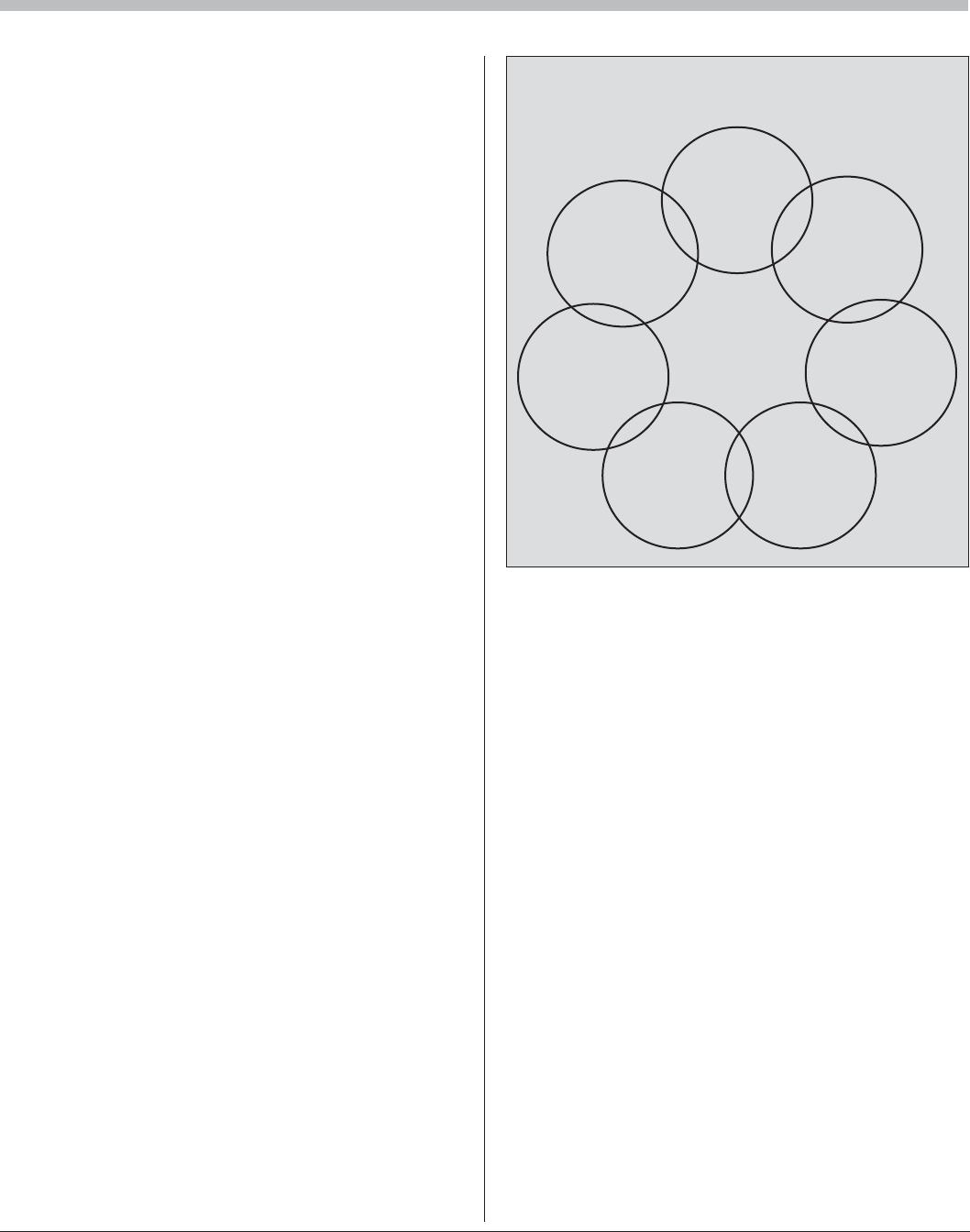
What To Do After High School
Find your circles of interest and begin the
research needed to reach your goals.
Apprenticeship programs
An apprentice is a person who is—
■ At least 16 years old,
■ Being trained in a particular trade by a skilled
worker under a planned program on the job,
■ Taking classroom instruction (through adult educa-
tion, at a community college, or in regular school if
in a part-time job), and
■ In training anywhere from one to six years (depend-
ing upon the trade—averaging three to four years).
Some additional facts:
■ Employment is based on supply and demand
■ The person wanting an apprenticeship may apply to
and have a contract with one of the following:
● An employer in the trade
● The association of employers
● The joint apprenticeship committee
● The organization of employees registered with the
apprenticeship council
For further information about specific apprenticeship
programs, check in the college/career center and/or
meet with your counselor.
College/University
There are several types of colleges and universities. The
college/career center at your school and your counsel-
ors have additional resources to help you choose the
right school to pursue your career interests.
Military training
You can learn about your chances for success in the
military by taking the Armed Services Vocational Ap-
titude Battery (ASVAB). This test is given at local high
schools free of charge.
Men and women may enlist in all branches of the
military. Enlistment procedures are similar, but the
services differ in length of enlistment and opportuni-
ties for specific training. Active military enlistments
are available in the U.S. Army, Navy, Air Force, Marine
Corps, and Coast Guard.
Trade and technical training
The Thomas Edison High School of Technology and
many high schools offer a variety of programs in
which students may obtain technical training during
high school. Landscaping, biotechnology, and systems
engineering technology are a few of the programs that
begin in high school and continue at Montgomery
College. For more information about specific career
pathway programs, go to www.montgomeryschools.
org/departments/cte/toolkit/index/shtm.
Community colleges, adult education, and private
schools have trade and technical training programs for
people who are no longer in high school.
Work/Postsecondary education
If you decide to get a job immediately after high school
you should—
■ Develop some job-finding and job-keeping skills,
■ Talk to a counselor or a college/career information
coordinator
about job possibilities and/or visit the
Maryland State De
partment of Employment and
Training office,
■ Visit with a career and college research and develop-
ment teacher in your high school,
■ Visit your career and media centers,
■ Talk with employers about combining work and a
part-time college program, and
■ Investigate career education courses that match
your interests.
College
Trade/Technical
School
Apprenticeship
Programs
Community
College
Military
Training
University
Work
14 • What To Do After High School

College Planning
Going to college is one of many options available to you
as you pursue your career plans. In either case, a cer-
tain amount of planning is required. The high school
plan that you made with your parents and counselor
should reflect courses that meet college entrance re-
quirements. Course choice and the level should reflect
your academic abilities, talents, and career interests.
Certain courses act as gatekeepers for college entrance.
Algebra and geometry are two such courses. Aspiring
to go to college can become a self-fulfilling prophecy.
Education is important not only for its own sake, but
people with more education have higher earnings
within virtually all occupations.
No matter what your postsecondary (after-high-school)
goals are, planning is important. Graduation require-
ments are complicated, and several options or pro-
grams are available to you as you move through high
school. The Seven Keys may guide you as well.
You completed a high school plan in Grade 8 as you
prepared to enter high school. Now that you are in high
school it is important to reevaluate and revise your
plan. You will need to do this yearly with your parents
and counselor. Make sure that the choices you make
this year will help you reach your career plans for after
high school.
The Student Educational and Planning Worksheet
(MCPS Form 560-45) can serve as a way to ensure that
you meet all graduation requirements and prepare for
your postsecondary goals (see page 19). Use it in con-
junction with your MCPS High School Course Bulletin
to create or update your own high school plan. Your
high school counselor will assist you.
College admission requirements
Know the requirements for a high school diploma and
the requirements of the colleges. All state universities
in Maryland require successful completion of specific
high school courses, 4 credits in English, a minimum
of 3 credits in each of the disciplines of social studies
and science, and a minimum of 2 credits in a foreign
language. A minimum of 4 credits in mathematics
also is required, which must include Algebra 1, geom-
etry, and Algebra 2. The most competitive universities
and colleges throughout the United States may re-
quire more credits in some of the courses listed. Your
choice of college major also may determine whether
you should take more than the minimum number of
credits.
To find out the admission requirements for particular
colleges and universities, visit the college/career center
and review college catalogues.
College Admissions and
Placement Tests
Different tests are used for different purposes within
the college admissions and placement processes. Some
tests (the SAT, the ACT, and under certain circumstanc-
es the SAT Subject Tests) may be used by colleges and
universities in making the admissions decision. When
applying to college, it is very important that you de-
termine which test or tests (if any) they require when
applying for admission.
Some tests (the PSAT from the College Board and the
PLAN and the EXPLORE from ACT) can be used to
help you determine how prepared you are for SAT and
ACT. The PSAT is also used as the qualifying test for the
National Merit Scholarship competition when taken
in the 11th grade. It is important that you work with
your counselor and other staff members at your school
to determine which tests are in your best interest. It
is also important that you are adequately prepared for
these tests.
Some tests (the College Board Subject Tests, the
Advanced Placement Tests, the ACCUPLACER, and the
Test of English as a Foreign Language (TOEFL) can be
used to determine the levels of the courses that you
will be able to take once admitted to a college or uni-
versity. In some cases you can even earn college credit
with sufficiently high scores on Advanced Placement
Tests. Again, it is very important that you determine
from the colleges or universities what their policies are
with regard to these tests.
There are many websites that are sources of valuable
information about college admissions and placement
tests.
■ PSAT (www.collegeboard.com/student/testing/psat/
about.html)
■ SAT (www.collegeboard.com/student/testing/sat/
about.html)
■ College Board Subject Tests (www.collegeboard.com/
student/testing/sat/about/SATII.html)
College Planning • 15

■ Advanced Placement Tests (www.collegeboard.com/
student/testing/ap/about.html)
■ ACT Test (www.act.org/aap/)
■ PLAN—The ACT Test for 10th graders
(www.act.org/plan/)
■ EXPLORE—The ACT Test for eighth and ninth
graders (www.act.org/explore/)
■ Test of English as a Foreign Language (TOEFL)
(www.ets.org/)
■ Accuplacer (www.collegeboard.com/student/testing/
accuplacer/)
Students with documented learning or other disabili-
ties may be able to utilize testing accommodations
for college admissions and placement tests. To do so,
they need to apply directly to the testing company to
be granted access to accommodations on those tests
owned by the testing company. Information about
these processes can be found at—
■ Testing Accommodations on College Board Tests
(www.collegeboard.com/ssd/student/index.html)
■ Testing Accommodations on ACT Tests
(www.act.org/aap/disab/index.html)
Early college-planning tips
Grade 9
■ Read
■ Make sure your courses reflect a college preparatory
curriculum. The caliber of subjects you choose and
the grades you earn become the most important
record colleges use in making admissions decisions.
■ Make an appointment with your counselor to discuss
academic, career, and personal issues.
■ Speak with your counselor about taking the PSAT
or PLAN as a practice test. Remember, however, that
only students who take the PSAT in the junior year
of high school can qualify for National Merit scholar-
ships. The test may be taken each year.
■ Talk with your parents and teachers about your
interests, aspirations, and goals.
■ Visit the college/career center and get information
about careers, colleges, financial aid, and scholarship
opportunities.
■ Visit college campuses as you vacation with your
parents.
■ Participate in extracurricular school/community
activities.
■ Complete class assignments and homework, and
participate in class discussions and activities.
Remember that the grades you earn in Grade 9 are a
part of your official high school transcript.
■ Maintain excellent attendance.
Grade 10
■ Read
■ Continue using all the tips offered for Grade 9.
■ Speak with your counselor about meeting with col-
lege representatives who visit your school.
■ Take the PSAT.
■ Find out what kinds of postsecondary schools offer
the education you need to meet your career plans.
■ Plan next year’s program to reflect your interests
and abilities.
■ Consult with your counselor and teachers about
taking SAT Subject Tests in subjects you have
completed.
■ Consider career and technology course offerings at
the Thomas Edison High School of Technology.
■ Identify career interests, aptitudes, and abilities
using an interest inventory available in your career
center.
■ Visit the college/career center and speak with the
college/career information coordinator and your
counselor about scholarship opportunities.
■ Develop skills in interviewing and completing job/
college applications.
Articulation Program at Montgomery College
MCPS students can receive up to 18 free college tech prep
credits at MC for courses taken in an MCPS high school.
The booklet, Articulation Agreements Between Mont-
gomery County Public Schools and Montgomery College,
details the Career and Technology Education (CTE) career
pathway programs and courses for which articulation
agreements exist. To learn more about the details of spe-
cific articulation, go to www.montgomeryschoolsmd.org/
departments/cte/toolkit/index.shtm
16 • College Planning

Explore options
■ Talk with your counselor and visit the school’s
career center to identify a list of 6 to 10 schools that
interest you, based on academic programs, admis-
sions requirements, cost, financial aid opportunities,
location, size, social activities, etc.
■ Narrow the list by familiarizing yourself with the
services each school can provide to special-needs
students.
■ Visit the school, if possible, to get an impression of
campus life, classes, residential facilities, etc.
■ Contact the Disability Support Services Office at the
college to get your specific questions answered.
Complete the application process
■ Understand admissions requirements for the schools
you select and be sure you are able to provide ev-
erything that is requested. You are not required to
disclose your disability. Discuss with your counselor
and your family whether or not you will share that
information. Colleges may not use the disability as
a basis for denying admission. On the other hand,
they are under no obligation to alter their admis-
sions requirements or standards for students with
disabilities. You must meet the admissions criteria
established by the school.
■ Follow your high school’s application timeline to be
sure all requirements are completed on time.
■ Complete, then submit your application(s).
■ Make the most of your senior year!
A Quick College-Planning Guide for
Students with Special Needs
Did You Know?
Individuals with Disabilities Education Act
(IDEA), the “special education law,” does not ap-
ply to higher education. Postsecondary institu-
tions are not required to design special programs
for students with disabilities, only to provide
accommodations that allow for equal access to
the regular program.
Students with a 504 plan (under Section 504 of
the Rehabilitation Act of 1973) may also work
with their college to determine accommodations
that allow for equal access to the regular
program.
There are many factors to consider when selecting a
college. In addition to exploring programs, location,
size, cost, housing, career, and social opportunities, you
also want to search for schools that offer the services
you need to succeed academically. This guide is de-
signed to help you with that search. When comparing
one college with another, try using the questions on
page 18.
Develop self-awareness
■ Become familiar with how you learn best.
■ Understand your strengths as well as your special
needs.
■ Know which accommodations work best for you and
apply them to your learning.
■ Build strengths and areas of interest through
extracurricular activities, service learning projects,
internships, or work experiences.
Practice self-advocacy
■ Prepare to assume responsibility for advocating
for yourself in college by practicing while in high
school.
■ Attend your Individualized Education Program (IEP)
meetings and be an active participant.
■ Use logical, clear, and positive language to commu-
nicate your successes and concerns.
■ Learn to be comfortable describing to others how
you learn most effectively, your disability, and you
academic needs.
Prepare yourself well
■ Take the most challenging courses available to you
and work hard in each of them.
■ Talk with your counselor and teachers about the
standardized tests you will need to take and plan a
testing timeline.
■ Consult with your counselor about whether or not
you will qualify for accommodations on standard-
ized tests, how and when to apply for those accom-
modations, and the testing plan that best meets your
needs.
A Quick College-Planning Guide for Students with Special Needs • 17
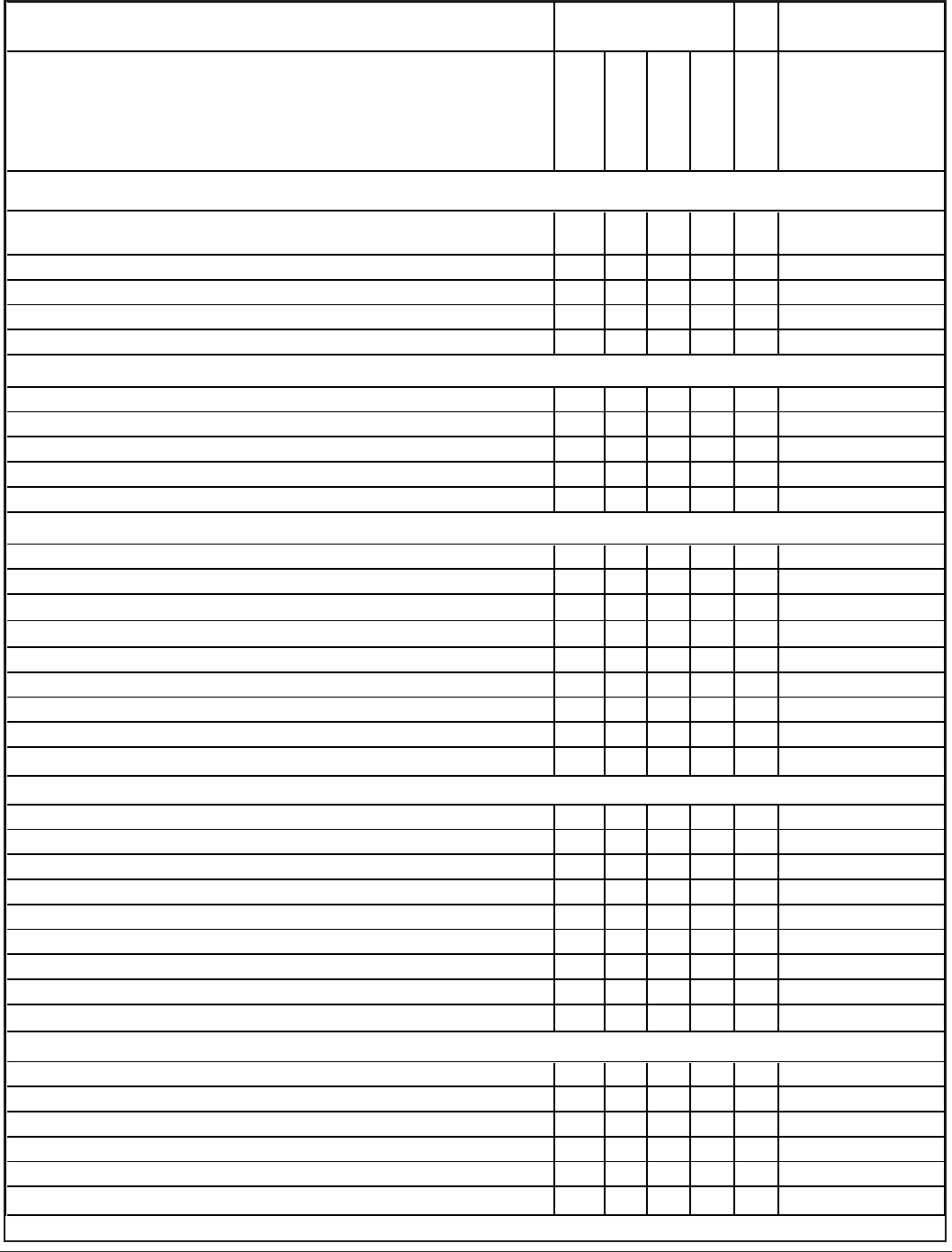
QUESTIONS NOTES
Write the names of colleges that interest you at the top of the columns
right. Then mark a Y (for yes) or an N (for no) in response to each
question, based on what you learn at the MCPS College Fair through
talking with an admissions representative, consulting with your counselor,
or gathering information from your high school career center.
ADMISSIONS
Are admission criteria for students with special needs the same as for other
students?
Are any special assessments required?
Is diagnostic testing available?
Is there a unique summer orientation for students with special needs?
Is documentation required to demonstrate special needs?
ACADEMIC SUPPORTS
Is the process for accessing special needs clear and easy to follow?
Is there a fee for supports?
Is tutoring available?
Is remediation in basic skills available?
Are study skills courses available?
AUXILIARY AIDS: Does the school provide the following?
Calculators
Laptop computer
Personal desktop computer
Scan-and-read programs
Screen-enlarging programs
Screen readers
Speech-recognition programs
Spelling/grammar assistants
Other
AUXILIARY SERVICES:
Does the school
p
rovide the followin
g
?
Advocates
Alternative exam arrangements
Duplicating at no cost or reduced cost
Mentors
Note takers
Priority registration
Readers
Scribes
Other
STUDENT SUPPORTS: Does the school offer the following?
Career counseling
Career placement
Internship programs
Individual counseling
Small-group counseling
Student organizations for special needs students
Derived from Peterson’s Colleges for Students with Learning Disabilities or Attention Deficit Disorders
NAMES OF
COLLEGES
to the
18 • A Quick College-Planning Guide for Students with Special Needs

Student Educational and
Planning Worksheet
Student Educational and
Planning Worksheet
Department of Student Services
MONTGOMERY COUNTY PUBLIC SCHOOLS
Rockville, Maryland 20850
MCPS Form 560- 45
May 2008
For graduation, students must earn a minimum of 22 credits, complete a program option, pass the High School Assessments,
and earn the required number of Student Service Learning (SSL) hours. Please complete both sides of this form.
Student
Home Phone - -
Last First Middle
Grade
Birth Date / / Student ID # Counselor
Career Interests by cluster:
E-mail
□ Arts, Humanities, Media, and Communications □ Biosciences, Health Science, and Medicine
□ Business Management and Finance □ Construction and Development
□ Education, Training, and Child Studies □ E
ngineering, Scientifi c Research, and Manufacturing Technologies
□ Environmental, Agricultural, and Natural Resources □ Human and Consumer Services, Hospitality, and Tourism
□ Information Technologies □ Law, Government, Public Safety, and Administration
□ Transportation, Distribution, and Logistics
Post-Secondary Goal:
□ 4-year college □ 2-year college □ Technical training □ Full-time employment □ Military
DISTRIBUTION: COPY 1/School Counselor; COPY 2/School Counselor w/signature; COPY 3/Parent with signature
Subject¹
Area
Credits
Required
9th Grade
Year
Credits
Earned
10th Grade
Year
Credits
Earned
11th Grade
Year
Credits
Earned
12th Grade
Year
Credits
Earned
TOTAL
CREDIT
English¹ 4
Social
Studies
3
Mathematics 4
Science 3
Fine Arts 1
Technology
Education
1
Physical
Education
1
Health
Education
0.5
(Continue on Side 2)
1
See MCPS Course Bulletin for admission requirements to all Maryland state colleges and MCPS Certifi cate of Merit requirements.
This form is available at www.montgomeryschoolsmd.org/departments/forms/
0.0
0.0
0.0
0.0
0.0
0.0
0.0
0.0
0.0
0.0
0.0
0.0
0.0
0.0
0.0
Student Educational and Planning Worksheet • 19
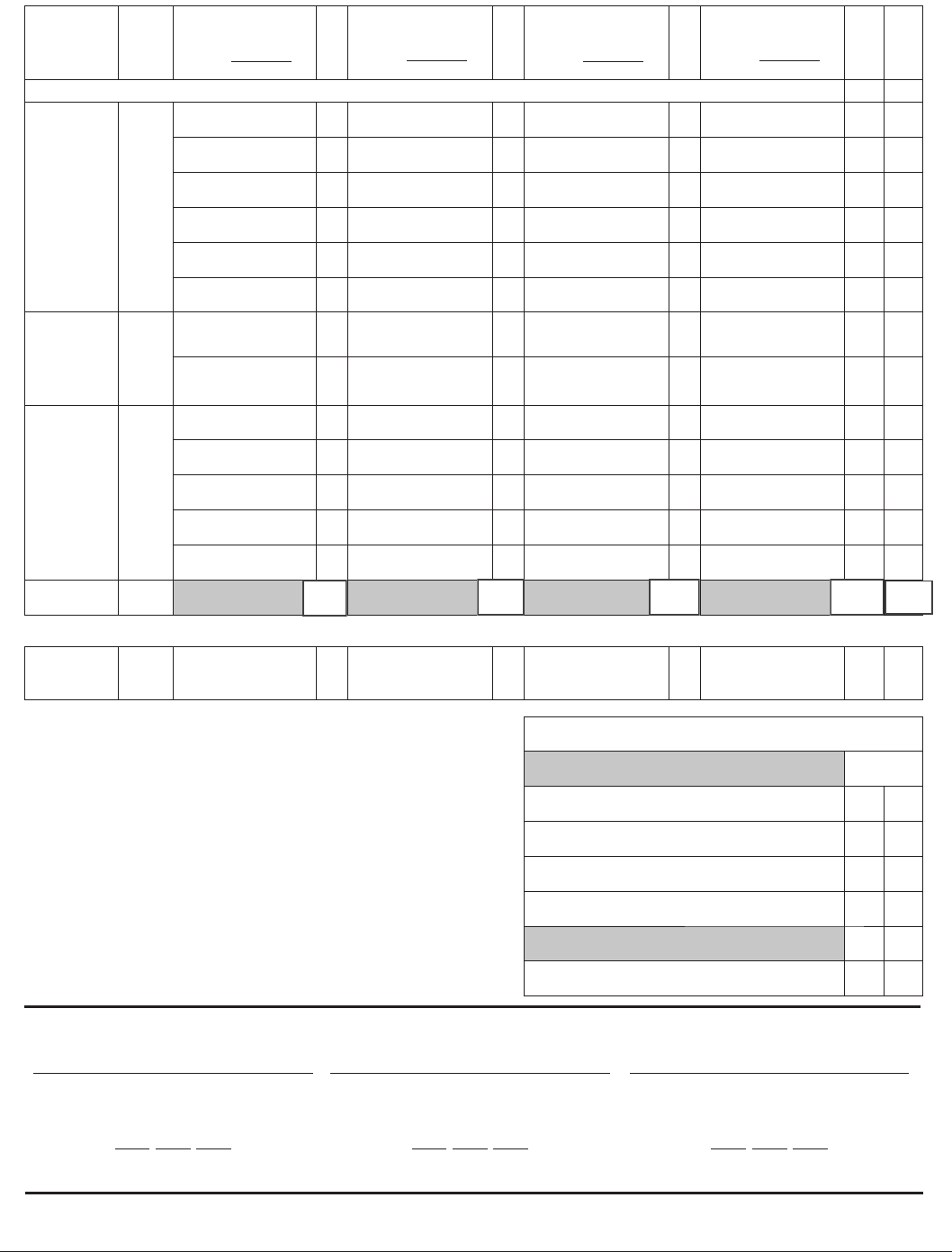
Program
Options
Credits
Required
9th Grade
Year
Credits
Earned
10th Grade
Year
Credits
Earned
11th Grade
Year
Credits
Earned
12th Grade
Year
Credits
Earned
TOTAL
CREDIT
Students must complete at least one of the program options listed below to meet graduation requirements.
OPTION 1:
Foreign
Language
or
OPTION 2:
American Sign
Language
or
OPTION 3:
Advanced
Technology
Education
2
OR
or
OPTION 4:
Career
and
Technology
Program
4
and
Additional
Electives²
2.5
Total Credits
Student
Service
Learning
3
75 hrs.
2
List only classes in subject areas not mentioned above.
3
Students graduating in 2008, 2009, or 2010, must earn 60 SSL hours.
Students graduating in 2011 and after must earn 75 SSL hours.
HIGH SCHOOL ASSESSMENTS
SCORE
Algebra and Data Analysis
English
Government
Biology
Yes No
REQUIREMENT MET
MCPS Form 560- 45, 2/08 DISTRIBUTION: COPY 1/School Counselor; COPY 2/School Counselor w/signature; COPY 3/Parent with signature
This form is available at www.montgomeryschoolsmd.org/departments/forms/
APPROVALS
Signature, Student Signature, Parent/Guardian Signature, Counselor
/ / / / / /
Date Date Date
0.0
0.0 0.0 0.0
0.0
0.0
0.0
0.0
0.0
0.0
0.0
0.0
0.0
0.0
0.0
0.0
0.0
0.0
20 • Student Educational and Planning Worksheet
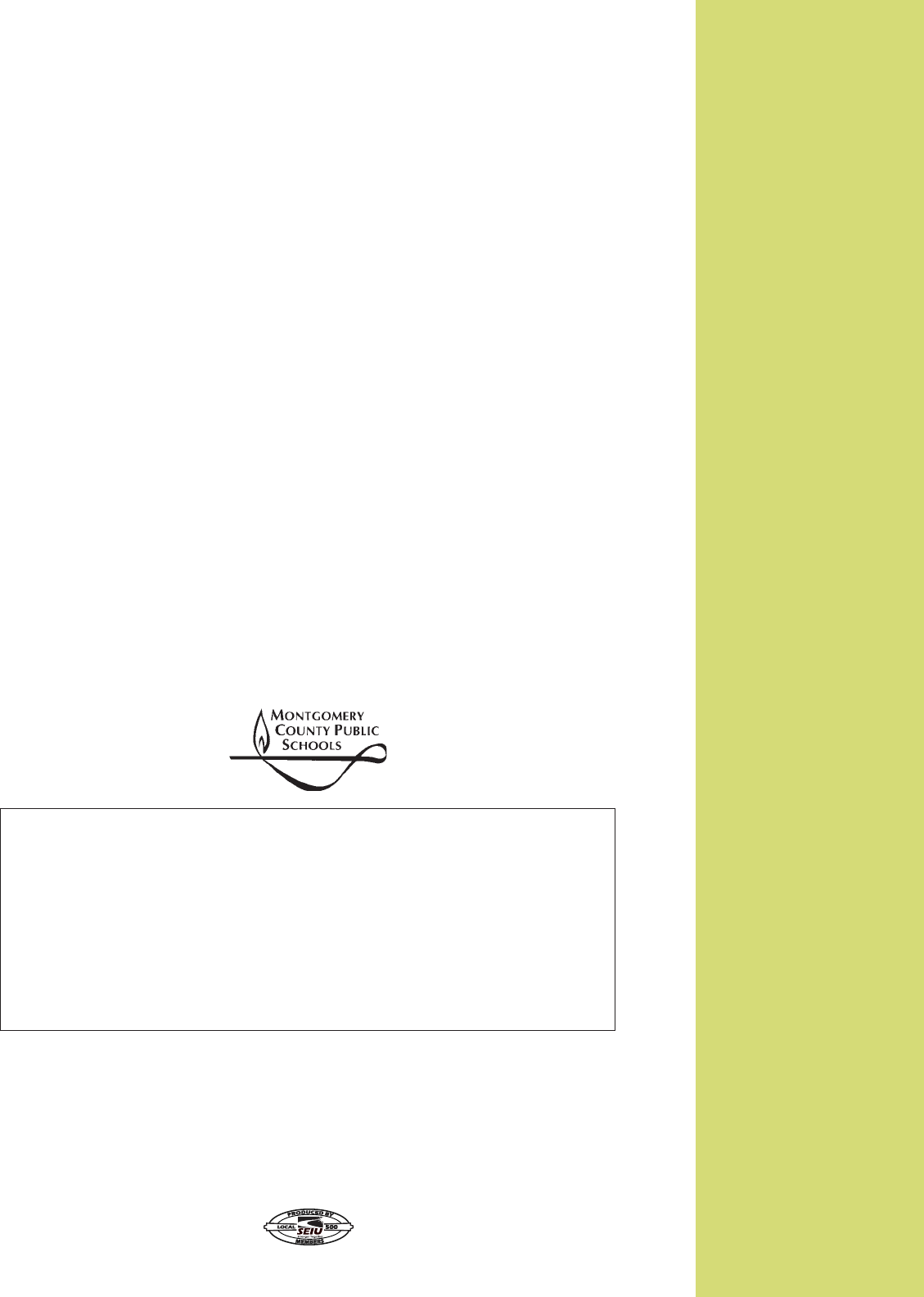
© 2009 Montgomery County Public Schools, 850 Hungerford Drive, Rockville, Maryland 20850-1744
0124.10ct • Editorial, Graphics & Publishing Services • 11/09 • 14,700
Published by the Office of Communications and Family Outreach
for the Office of Special Education and Student Services
This document is available in an alternate format, upon request, under the Americans with Disabilities
Act, by contacting the Public Information Ofce, at 850 Hungerford Drive, Room 112, Rockville, MD
20850, or by phone at 301-279-3391 or via the Maryland Relay at 1-800-735-2258.
Individuals who need sign language interpretation or cued speech transliteration in communicating with
Montgomery County Public Schools (MCPS) may contact Interpreting Services in the Deaf and Hard
of Hearing Program at 301-517-5539.
MCPS prohibits illegal discrimination on the basis of race, color, gender, religion, ancestry, national
origin, marital status, socioeconomic status, age, disability, physical characteristics, or sexual orientation.
Inquiries or complaints regarding discrimination or Title IX issues such as gender equity and sexual
harassment should be directed to the Ofce of the Deputy Superintendent of Schools at 301-279-3126,
via the Maryland Relay at 1-800-735-2258, or addressed to that ofce at 850 Hungerford Drive, Room
129, Rockville, MD 20850.
